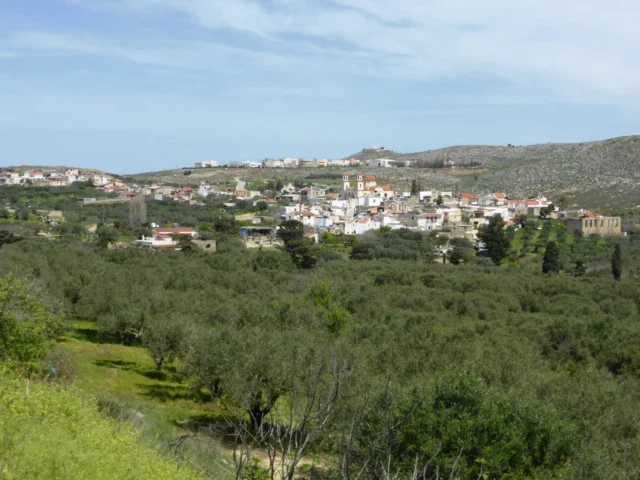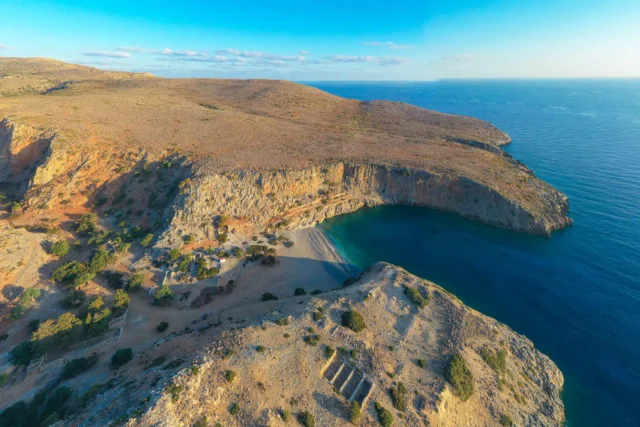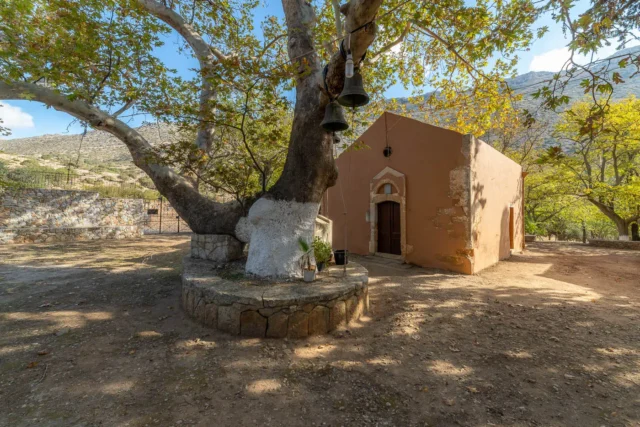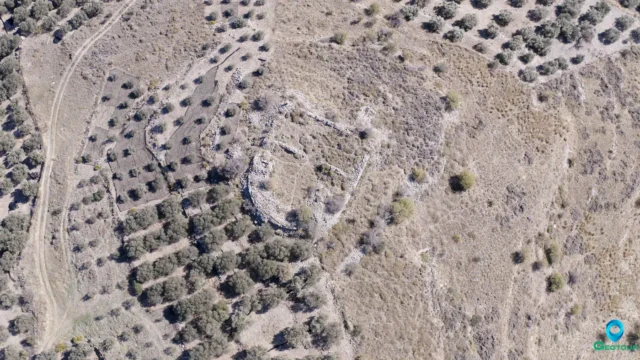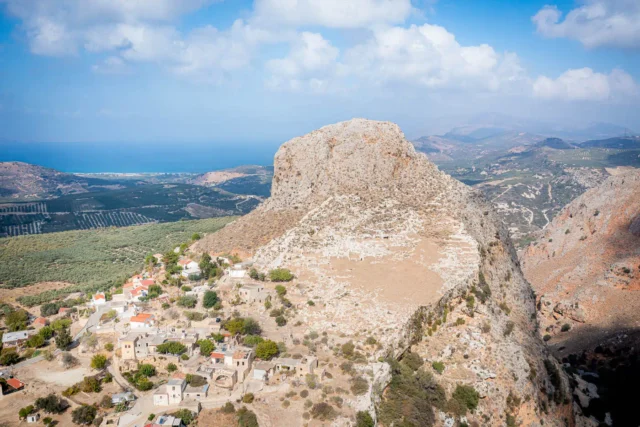748
listings found
Categories
Active filters:
Lagou, Lasithi plateau
Lagou is a settlement located in the Lasithi regional unit on the island of Crete, Greece. It belongs to the Municipality of Lasithi plateau
Lyttos (Xidas), Minoa – Pediada
Lyttos (until 1987 known as Xidas) is a village in the Municipality of Minoa Pediada, Heraklion regional unit, Crete, Greece. It is located at an altitude of 510 meters on […]
Patsideros, Minoa – Pediada
Choumeri is a settlement located in the Heraklion regional unit on the island of Crete, Greece. It belongs to the Municipality of Minoa - Pediada
Anopoli, Chersonissos
Anopoli is a settlement located in the Heraklion regional unit on the island of Crete, Greece. It belongs to the Municipality of Chersonissos
Aitania, Chersonissos
Aitania, a village in Heraklion, Crete, is 20 km from Heraklion. Its name is believed to be a corruption of the ancient city of Diatonion. Aitania is recorded in a Venetian document from 1212 as "Icania." The Venetian census of 1583 lists it as "Itagnia Cato" with 112 inhabitants and "Itagnia Apano" with 85 inhabitants. On October 12, 1856, a major earthquake with a magnitude of 8.2 struck Crete, causing significant damage and resulting in the death of 40 people in Aitania. In 1954, archaeologist N. Platon excavated a small, cave-like carved tomb west of Aitania at a site called "Fonias." The tomb contained approximately thirty Geometric period vessels. The village square is a central gathering point for residents and visitors, with traditional cafes. The Cultural Association of Aitania organizes a Cretan feast in the square every year on August 15th.
Panagia Kardiotissa near Voroi
Former monastery north of Voroi, Crete. Features a double-aisled church with late 14th-century frescoes. Generally closed to the public.
The Church of Christ the Saviour in Temenia, Selino
The Church of Christ the Saviour is located in the Lazopouliana neighborhood in the village of Temenia, in the Selino region of Chania, Crete. This small church was built in […]
Ancient Elyros
Ancient Elyros, situated on Crete's 'Kefala' hill near Rodovani, originated in the Early Iron Age and thrived until Late Antiquity. Named after the mythical son of Apollo, it became a major urban center in southwestern Crete during the Classical period, known for trade and weapon manufacturing. As a leading city in the Oreioi League (formed in the 3rd century BC for security and economic reasons, including Hyrtakina, Lissos, Poikilasio, Syia, and Tarra), Elyros maintained external connections before the league's likely dissolution before 183 BC, a period when it was at war with Kydonia. The Roman era marked a time of flourishing for Elyros, evidenced by the "Philosopher of Elyros" statue. The city featured fortification walls, an aqueduct, cisterns, and a theater. Elyros minted its own coins, indicating autonomy, with emblems similar to Hyrtakina's. Its territory included the port of Lissos, a key economic contributor and religious center with an Asklepieion, as well as the coastal cities of Syia and Poikilasio. Archaeological findings suggest communication with mainland Greece, North Africa, and Southern Italy. Notably, Elyros had a local workshop producing unique glass pyxides. A rural sanctuary dedicated to Poseidon was also found in the 'Tsiskiana' area, likely under Elyros's jurisdiction.
The Ancient Port of Lissos
Lissos, an ancient Cretan port city, was a vital healing center and trade hub. It served the inland cities of Elyros, Hyrtakina, and Tarra. The sanctuary of Asklepios attracted pilgrims seeking cures.
Hyrtakina
Hyrtakina, an ancient Cretan city, thrived in the Oreia region near the White Mountains. As a member of the League of the Oreioi, it played a role in regional security and economic development. The city's strategic location on 'Kastri' hill was fortified by double walls. Hyrtakina's autonomy is evident from its unique coinage, featuring a wild goat and a bee. Trade connections extended to mainland Greece, North Africa, and Southern Italy, as shown by archaeological finds. The city's peak was in the 4th century BC, coinciding with its coin minting. Hyrtakina's agreement with Cyrene for grain supply highlights its interaction with other Mediterranean cities. The city was abandoned in Roman times.
Polyrrhenia: Fortifications and Acropolis
Polyrrhenia, an ancient city in western Crete near Kissamos, was occupied from the Iron Age to the Byzantine era. Its strategic hilltop location was protected by Hellenistic and Roman fortifications. The Acropolis featured a Byzantine castle, an early Christian basilica, and a potential temple to Artemis. A sophisticated water system, including an aqueduct with a defensive tower and underground reservoirs, sustained the population. The 19th-century Church of the 99 Holy Fathers incorporates ancient materials from the ruins.
Polyrrhenia
An Ancient City of Western Crete Polyrrhenia, also known as Polyrrenion, was a city in ancient Crete, located on the northern coast of the western part of the island . […]
The Ancient City of Falasarna
An ancient city on western Crete, with history from the Neolithic (c. 3500 BCE) to its Roman conquest in 67 BCE. A fortified Hellenistic maritime power involved in trade and piracy, it rivaled Polyrrhenia. Excavations have uncovered a Temple of Demeter with Archaic Daedalic offerings and a 4th-century BCE fortified harbor. The harbor's towers were destroyed by the 365 CE earthquake. Today, the site is a protected archaeological park with ongoing research.
Minoan tholos tomb at Maleme
The Minoan tholos tomb at Maleme, Crete, is a remarkable example of Bronze Age funerary architecture. Located near the village of Maleme in western Crete, the tomb is known for […]
Rokka archaeological site
Located inland in Kissamos, western Crete, on the slopes of Troulli hill. This protected archaeological site dates to the Hellenistic period (4th-2nd century BC). Its identity is debated, possibly being the ancient city of Keraia or linked to the "Koinon ton Modaion." The settlement features unique architecture with houses, cisterns, and stairways carved into the limestone. A necropolis with rock-cut tombs has yielded artifacts. The modern village hosts the annual Giortes Rokkas festival to promote cultural heritage and repopulation.
Pergamos Ancient City
Pergamos (Πέργαμος) was a city of ancient Crete, founded in the 8th century BC. It was one of the hundred cities of Crete mentioned by Homer in his works. It […]
Katre, an Ancient City of Crete
Katre, an ancient city of Crete, is shrouded in mystery and intrigue. While historical and archaeological evidence about Katre is limited, its strategic location and mythological connections suggest a place […]











